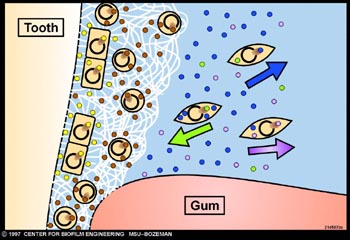Biofilm strategies: Signaling
 |
Schematic diagram showing how attachment blockers and detachment signals can be used to prevent cells of periodontal pathogens (Fusobacterium nucleatum) from joining the biofilm on teeth. Hundreds of species have been identified in the oral biofilms (dental plaque) that cause caries, and quite a lot is known about the sequence of colonization of many of these species. Cell-cell signaling has been implicated in some dental biofilm colonization events. |
|
|
Cell-cell communication in bacteria is associated with the accumulation of signal molecules that co-regulate gene transcription (quorum sensing). By holding cells in close proximity in a fluid environment, the biofilm matrix aids cell-cell communication. These signal molecules act at the global level, sometimes across species boundaries; consequently a wide variety of cellular functions are influenced. Practical ImplicationsDiscovering and using signals that affect bacterial behavior provides opportunities to develop new biofilm control strategies. This is particularly important as more and more bacterial become resistant to commonly used antibiotics. Studying natural means of bacterial control may reveal ways to reduce biofilm accumulation, thereby preventing some of the quorum-sensing toxin production that bacteria use to coordinate their activity. Bacterial signals have been shown to affect biofilm structure, attachment, detachment and other behaviors.
|
||

